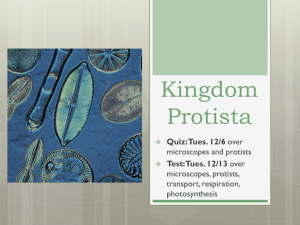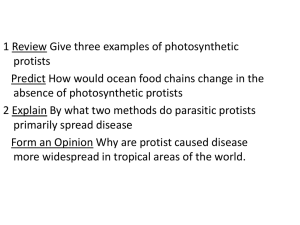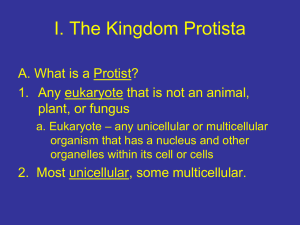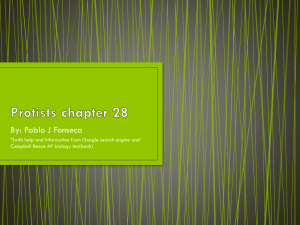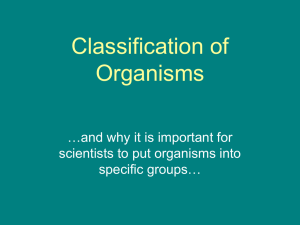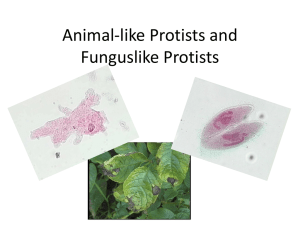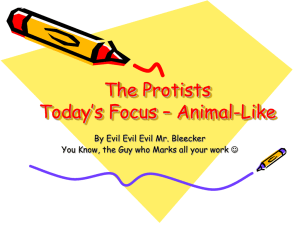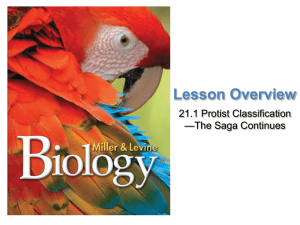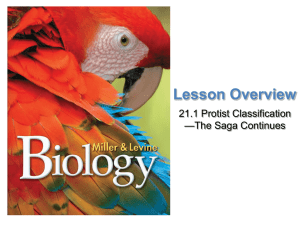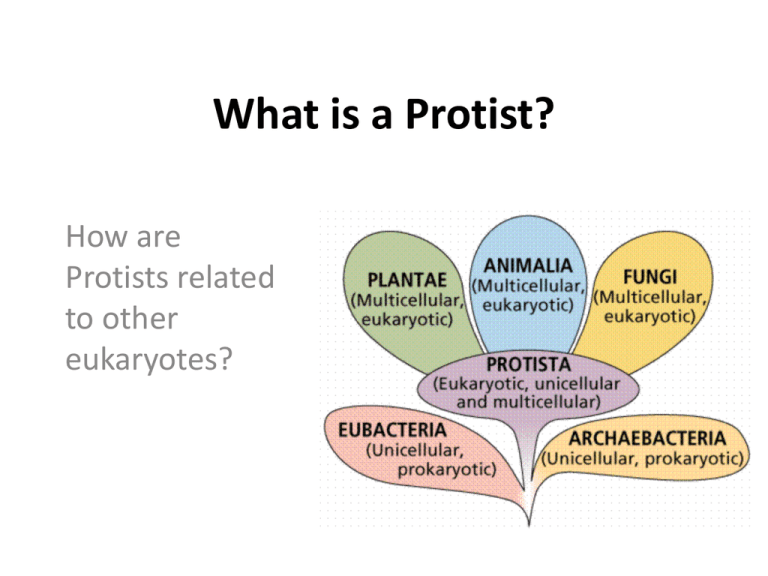
What is a Protist?
How are
Protists related
to other
eukaryotes?
Does everyone agree how to classify
protists?
• No, at present, biologists
do not agree how to
classify protists
• The amount of diversity
among the protists, is
much greater than within
or between the other
three eukaryotic
kingdoms
The Protist Dilemma
• Protists are grouped
together solely because
they are not fungi, plants
or animals
• Furthermore, many
protists are more closely
related to members of
other eukaryotic kingdoms
than they are to other
protists.
Current Protist classification
• It has been proposed that the protista
kingdom be divided into six groups or clades
• Today, while we still use the term Protist, this
is not a single kingdom, but a collection of
organisms in six clades
What is a Protist?
• A protist is a eukaryote
(has a nucleus)
• A protist is any
eukaryote that is not a
plant, animal or fungus
Evolution of Protista
Endosymbiont Hypothesis
Are all protists unicellular?
• No, although most are unicellular, some protists
are colonial, and some like the giant kelp are
multicellular.
Unicellular
Colonial
Multicellular
How do Protists Move?
Some move with flagella
• Long whip-like
projections
• One to two per cell
• Examples
– Trypanosoma
– Euglena
Trypanosoma
Euglena
Two flagella
No cell wall
Chloroplasts
How do Protists move?
Some move with cilia
Cilia can be used for
feeding and
movement
Cilia are short and
used like oars on a
boat
Example
Paramecium
Ciliates - Paramecium
Lysosomes
Trichocysts
Oral groove
Gullet
Anal pore
Contractile vacuole
Micronucleus
Macronucleus
Go to
Section:
Food vacuoles
Cilia
Some do not move
Those that do not
move produce spores
and live as parasites
Plasmodium causes
malaria
Cryptosporidium
spreads through
contaminated drinking
water and caused
intestinal disease
Excavates: feeding groove, flagella
• Diplomonads
– Giardia is an intestinal parasite that causes
cramping and diarrhea
• Discicristates
– Euglena is free living and can use its chloroplast
for photosynthesis or can live as a heterotroph
– Trypansoma causes African sleeping sickness;
carried by tsetse flies
Euglena
Chloroplast
Carbohydrate
storage bodies
Gullet
Pellicle
Flagella
Go to
Section:
Eyespot
Nucleus
Contractile
vacuole
Chromalveolates: very diverse group; most are
photosynthetic
• Phaeophytes = multicellular brown algae
• Chrysophytes = unicellular golden algae
• Diatoms = unicellular algae with intricate silicon
dioxide (silica) shells
• Ciliates = paramecium are not photosynthetic
• Dinoflagellates = half are photosynthetic, half are
heterotrophs; some are luminescent
• Apicomplexans = parasitic Plasmodium
Brown algae
Phaeophytes
• Photosynthetic
• Chlorophylls a and c
• Brown accessory
pigment fucoxanthin
• Multicellular
• Giant kelp, Fucus
Photosynthetic protists
• Chrysophytes
“Golden plants”
Gold-colored
chloroplasts
Cell walls contain pectin
instead of cellulose
Store food as oil rather
than starch
Can form thread like
colonies
Photosynthetic protists
Diatoms
Glass like cell walls
Cell walls contain silicon
(Si)
Cell walls like petri dish
Photosynthetic
protists
Dinoflagellates
Luminescent
“Fire plants”
Half photosynthetic
Half heterotrophs
Two flagella
Apicomplexan
• Plasmodium
• Mosquito
borne
parasites like
the species
that causes
malaria
Cercozoa, Foraminiferan, Radiolarian
• Have pseudopods
• Many produce
protective shells
Heliozoan
Foraminiferans
Rhodophytes
Red Algae
• Chlorophyll a
• Red accessory pigment
– phycobilin
• Absorbs blue light
• Grows very deep
• Multicellular
• Nori
Ecology of photosynthetic protists
• Base of the food
chain
• Half of the
photosynthesis on
earth is carried
out by
phytoplankton
Ecology of photosynthetic protists
• Algal blooms
Caused by too much pollution
or nutrients
Deplete water of oxygen
Kill fish and invertebrates
Dinoflagellates cause “red
tides”
Red tides produce toxins which
can be taken in by shellfish.
Eating these shellfish can cause
illness, paralysis and death
Green algae
• Phylum Chlorophyta
• Same chlorophyll and cell wall composition as
green plants
• Chlorophyll a and b
• Store food as starch
• Found in fresh and salt water and on land
• Unicellular, colonial and multicellular
• Now classified with plants
Unicellular
green algae
• Chlamydomonas
Lives in ponds, ditches and
wet soil
Egg shaped
Two flagella
Large, cup-shaped
chloroplast
Colonial
green algae
• Spirogyra
Filamentous
Forms threadlike
colonies
Spiral chloroplasts
• Volvox
Hollow spheres
500 – 50,000 identical
cells
Some cell specialization
Human uses of algae
• Oxygen
• Food (nori; thickening agent (carrageenan) in ice
cream, egg nog, chocolate, salad dressing)
• Industry (plastics, waxes, paints, lubricants)
• Science labs (agar)
• Alternation of generation – alternating
between diploid and haploid organisms
• Diploid – having two copies of each
chromosome
• Haploid – having one copy of each
chromosome
• Gametophyte – haploid gamete producing
organism
• Sporophyte – diploid spore producing
organism
Heterotrophic protists
• Amoebozoa = Amoebas use pseudopods for
movement and feeding
• Ciliates = Paramecia use cilia to move food to gullet;
food vacuoles and lysosomes digest the food; waste
is released through the anal pore
• Slime Molds and Water Molds absorb food
through their cell walls from dead or decaying
matter; decomposers
Section 20-2
An Amoeba
Contractile vacuole
Pseudopods
Nucleus
Food vacuole
Go to
Section:
Slime molds
Slime molds
Water molds
• Cells are multinucleate
• Cell walls of cellulose
• White fuzz on dead fish in
water
• Plant parasites on land
Cause potato blight responsible for
potato famine
Reproduction in
water molds
• Can produce
sexually and
asexually
• Motile
(swimming)
spores
• Antheridium
produces
sperm
• Oogonium
produces eggs
Mutualistic relationships
• Zooxanthellae – live
inside coral and provide
food through
photosynthesis
• Trychonympha – live
in the gut of termites
and digest cellulose



